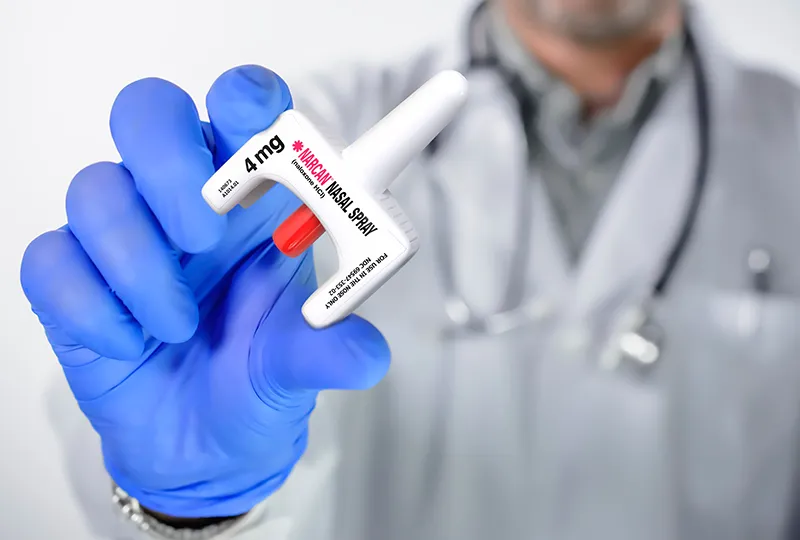compiled by Kym Byrnes
Naloxone: A Lifesaving Tool Against Opioid Overdose
People are continuing to die in Carroll County from drug overdoses. It might be easy to think it only impacts those suffering from substance use disorder, but in reality, it’s an issue that affects the entire community. In May, the Drug Enforcement Agency (DEA) stated, “The drug poisoning crisis remains a public safety, public health and national security issue.”
The overdose crisis has evolved, with the majority of deaths now caused by illicitly manufactured synthetic opioids, including fentanyl and, increasingly, stimulants. Many overdose deaths are accidental. A little knowledge can go a long way in potentially saving a life. Here’s what to know about drug overdose and naloxone.
What is Naloxone?
Naloxone, also known by its brand name Narcan, is a prescription medication that can temporarily reverse an opioid overdose, making it a critical tool in preventing fatal outcomes. Opioids include drugs like heroin and prescription medications such as oxycodone, hydrocodone, morphine, fentanyl, and methadone.
Why is Naloxone Important?
Having naloxone on hand can significantly reduce the risk of overdose death. It’s simple to use and effective in quickly restoring normal breathing in someone whose breathing has slowed or stopped due to an opioid overdose.
“Naloxone is a key harm reduction tool. It is simple to use, available at no cost and saves lives,” says Adrienne Sanders, harm reduction supervisor with the Carroll County Health Department. “I believe it should be in every first aid kit, so we are working to make it easily accessible all over the county.”
Who Should Carry Naloxone?
Health care professionals are hoping to destigmatize the conversation around naloxone. Even people who don’t use drugs or opioids should have naloxone on hand. Having more of this lifesaving drug in the community is essential. You could end up saving a friend or neighbor in need.
What are the and Symptoms of an Opioid Overdose?
Symptoms of overdose include:
– Shallow Breathing
– Cool and Clammy Skin
– Falling Asleep or the Inability to Wake Up
– Small Pupils
– Limp Body
If you see someone with these symptoms, call 911 right away. If you have naloxone, administer it immediately. Stay with the person until emergency crews arrive. Even if you’re unsure if someone is having an overdose and you have naloxone, administer it right away. If someone is experiencing overdose symptoms, administering naloxone is your best first action. It won’t hurt the person to have naloxone, even if it’s not an overdose. If the person doesn’t respond, continue performing CPR or using an AED until emergency crews arrive.
How to Get Naloxone
Naloxone is available across Maryland through various channels:
Overdose response programs: These programs offer free naloxone, along with fentanyl and xylazine test strips.
Local pharmacies: You can purchase naloxone over the counter, bill it to your insurance, or obtain it without an individual prescription.
New distribution points: To increase access, Maryland has implemented purple “newspaper” boxes as naloxone distribution points. In Carroll County, these boxes are at the Carroll County Health Department, Carroll Hospital, Carroll County government offices, several Carroll County Public Library branches, the Maryland Department of Human Services and several businesses.
Good Samaritan Laws Protect You
Maryland’s Good Samaritan laws protect you when you seek help for someone experiencing an overdose. You cannot be arrested, charged or prosecuted for possessing drugs or drug paraphernalia, or for providing alcohol to minors when calling 911 for an overdose. You are also protected from liability when administering naloxone in a good-faith effort to help someone.
Used your Naloxone? Report It
If you have used naloxone, it’s essential to report it to the Maryland Poison Center within two hours. This anonymous report helps ensure that naloxone continues to be available to those who need it.
More Information
For detailed guidance on how to administer naloxone and to find locations where you can obtain it, visit HowToAdministerNaloxone.Maryland.gov and StopOverdose.Maryland.gov.
Statistics
27 Overdose Deaths in Carroll County from August 2023 to July 2024
(Maryland Department of Health)
72 Overdose Deaths in Carroll County Peaked in 2018.
(Maryland Department of Health)
72.1% Overdose Deaths in 2020 in Maryland Were Male.
(Maryland Opioid Operation Command Center – StopOverdose.Maryland.gov)
In Maryland, from 2015 to 2020, fatal overdoses increased by 81.4% among individuals older than 55 while decreasing by 11.2% among individuals younger than 25.
(Maryland Opioid Operation Command Center – StopOverdose.Maryland.gov)

